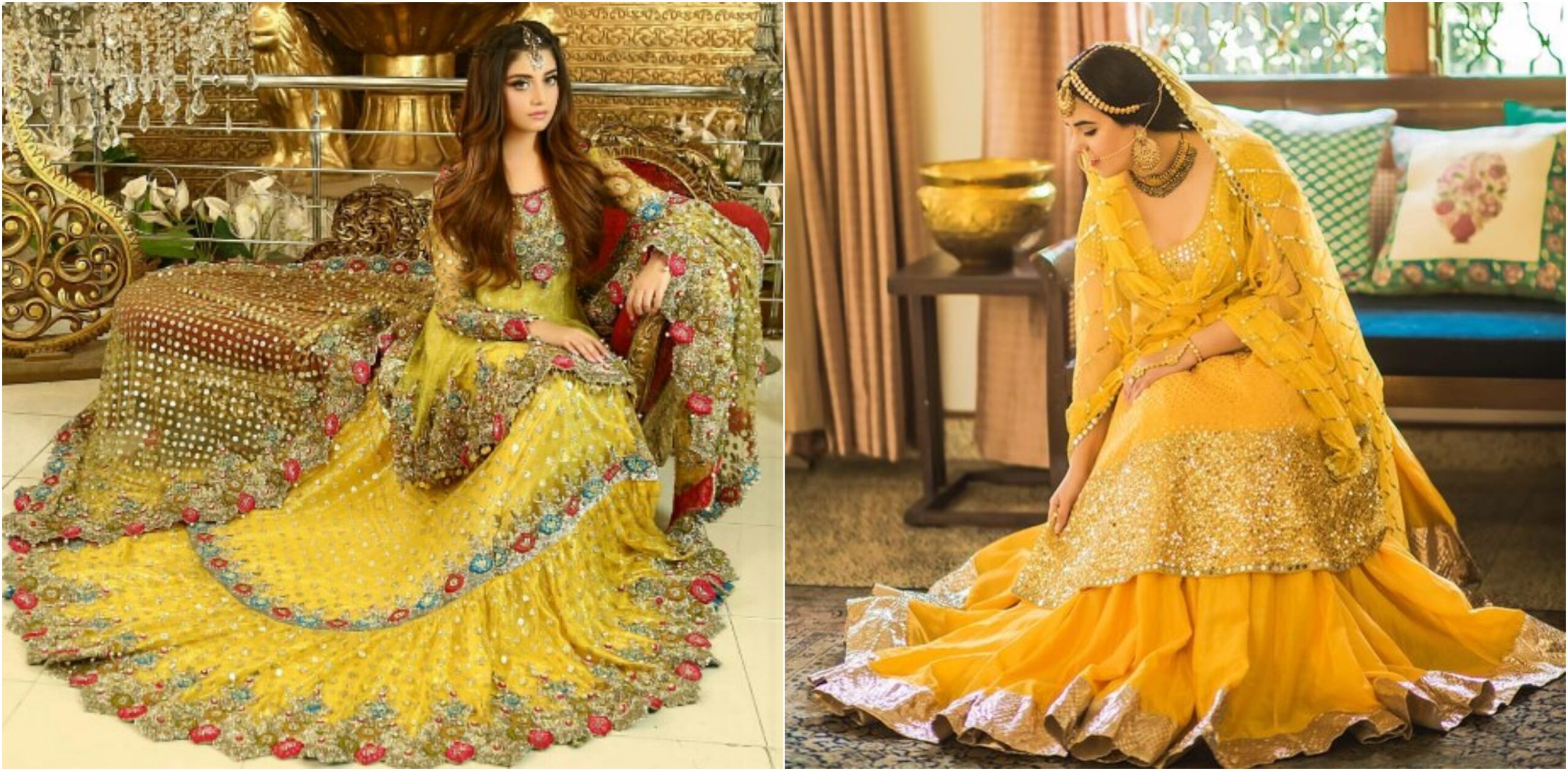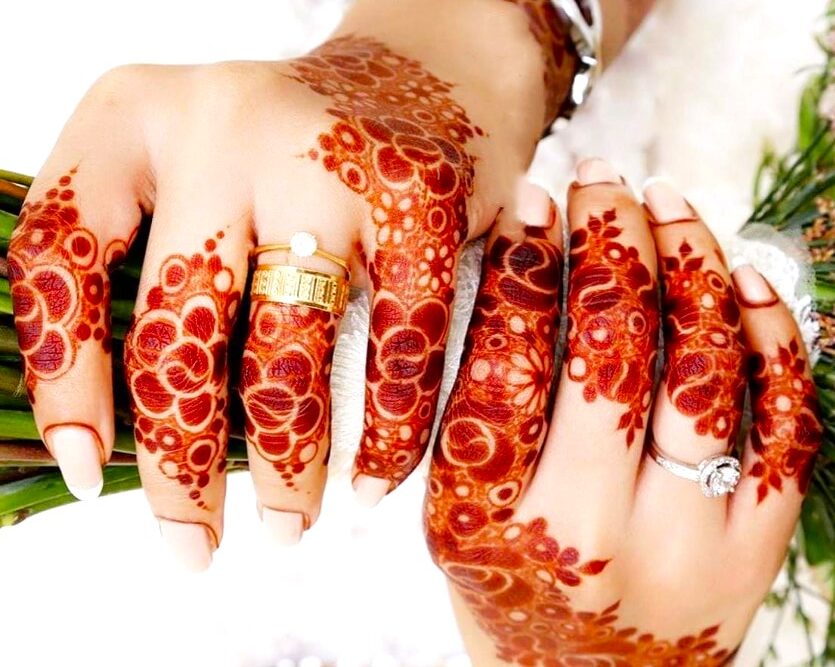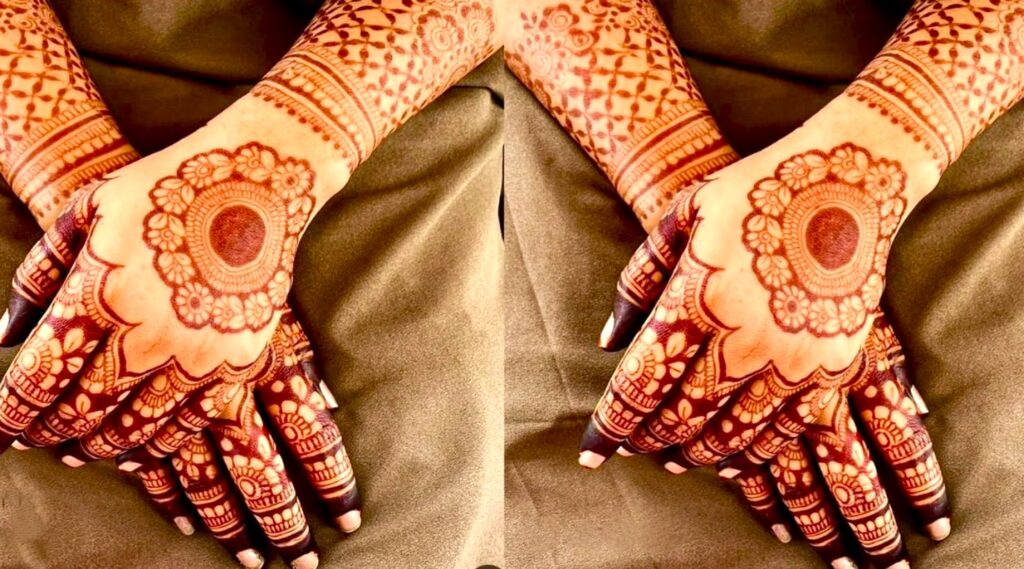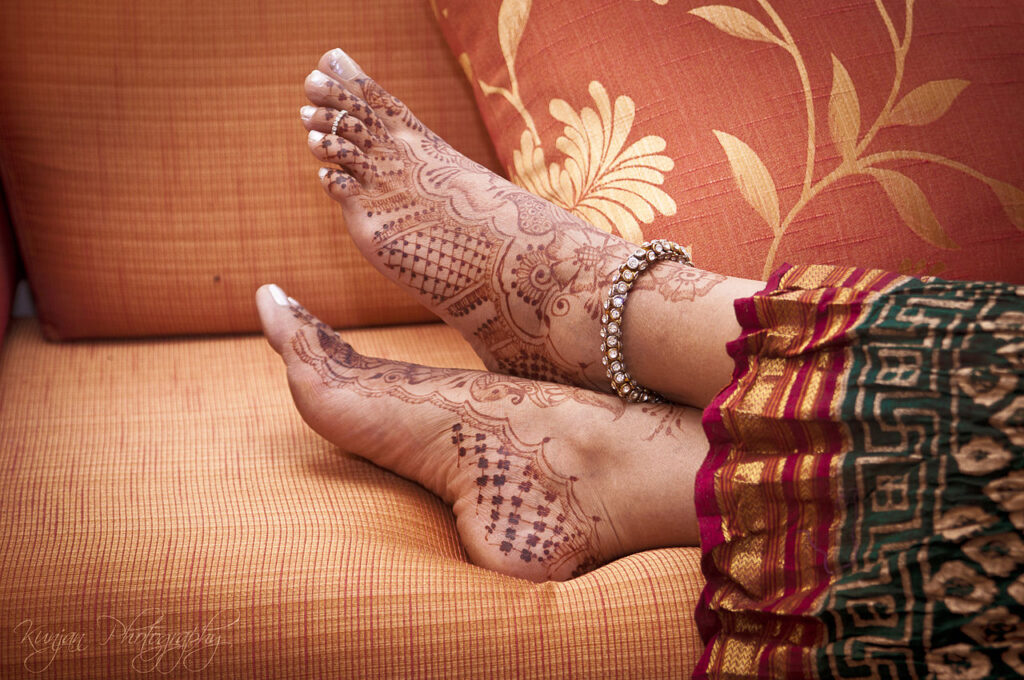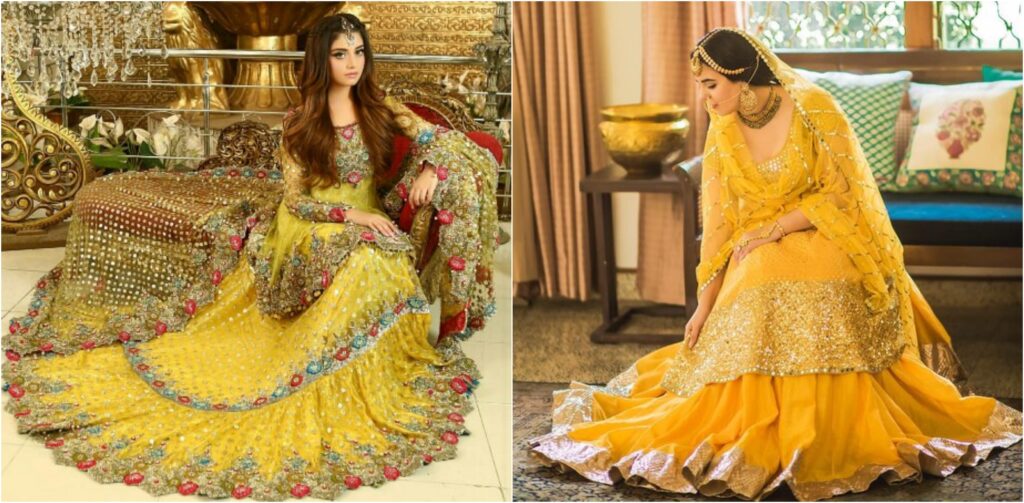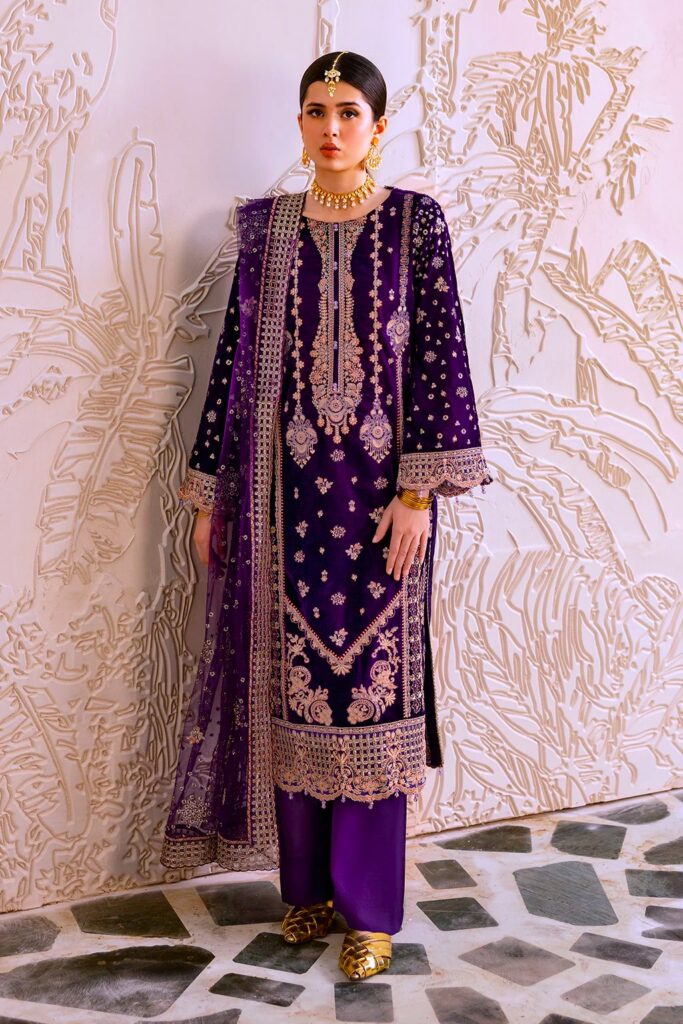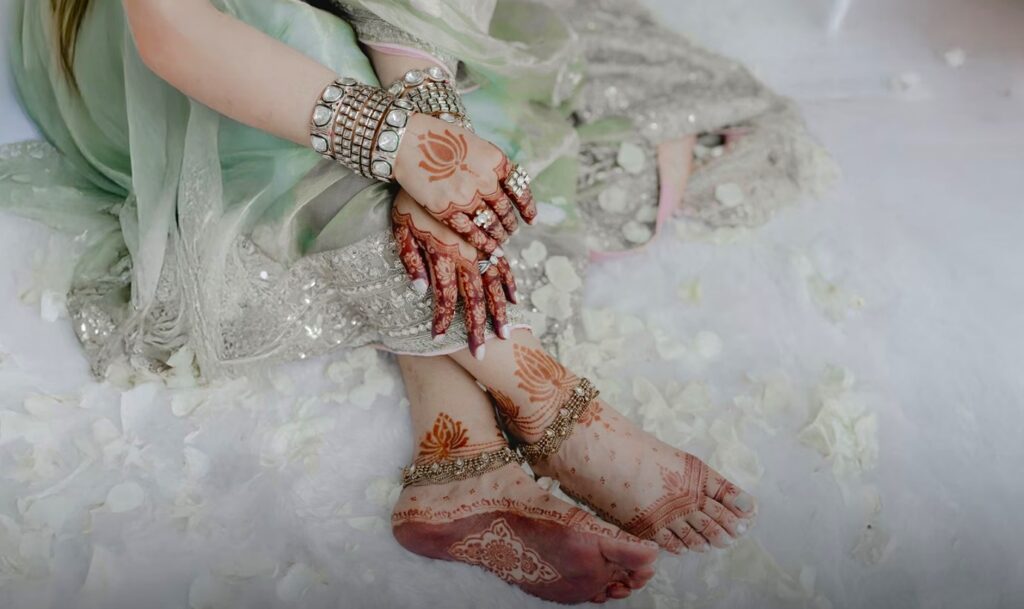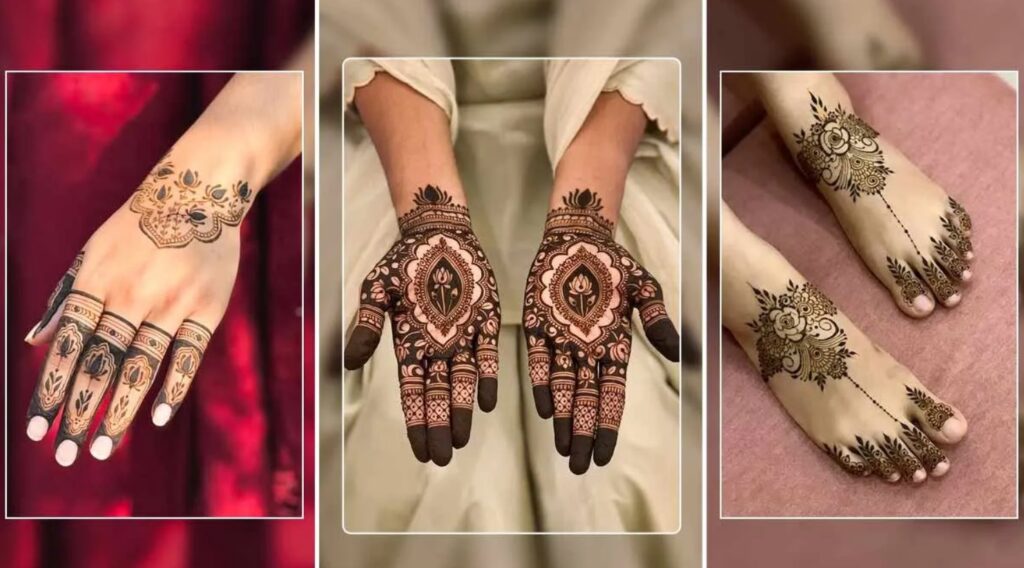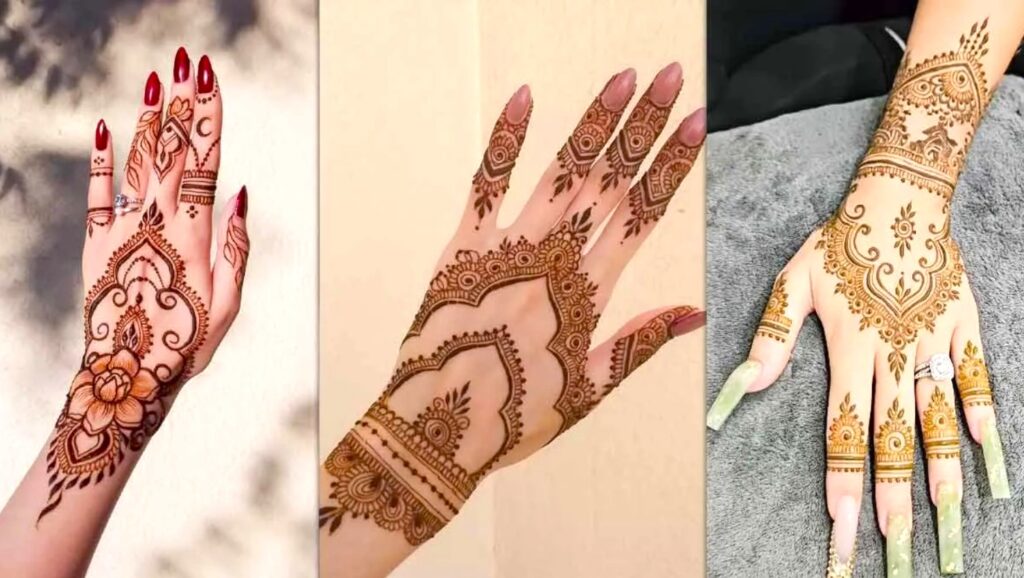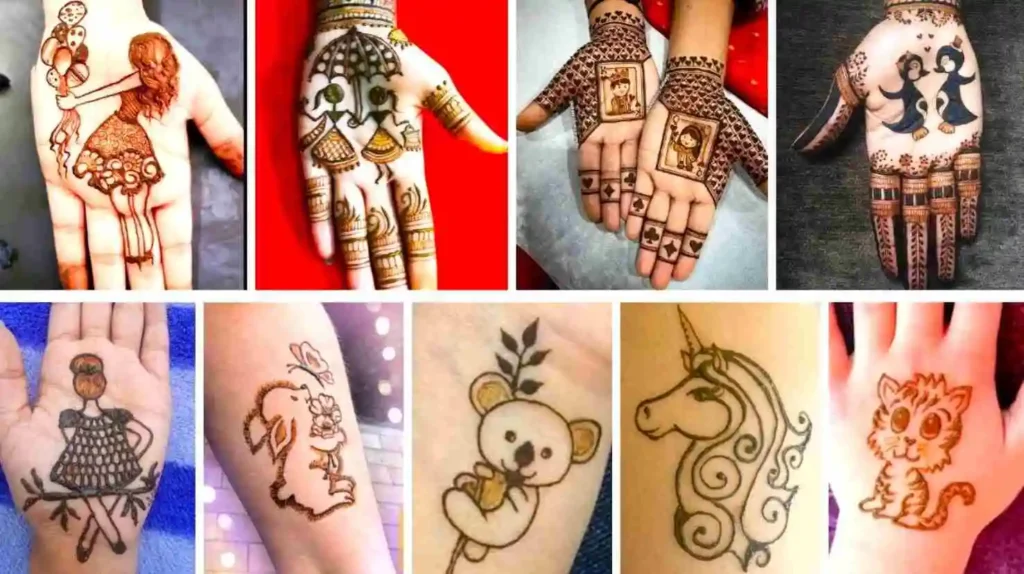Mehndi Dress Design
The air is thick with the scent of sandalwood and jubilant dholak beats, the very essence of celebration hanging like a shimmering veil. You are at the heart of a Pakistani wedding, a whirlwind of color, music, and emotion, and the Mehndi ceremony stands as its vibrant, joyous core. It is a festival within a festival, a day dedicated to laughter, dance, and the beautiful, intricate art of henna. At the center of this kaleidoscope is you, and your ensemble is more than just an outfit; it is a statement, a reflection of your joy, your culture, and your personal style. This is where the magic of the perfect mehndi dress design comes alive. It’s a harmonious dialogue between fabric and skin, where the vibrant colors and patterns of your attire dance in perfect synchrony with the delicate, dark tracery of your mehndi design. Choosing the ideal mehndi dress design is a nuanced art form. It’s a balancing act between traditional exuberance and contemporary flair, between bold self-expression and graceful elegance. Will you opt for the regal, tactile richness of a velvet dress design, or the breezy, romantic flow of chiffon? Should your mehndi design be a sprawling, traditional masterpiece covering your hands and feet, or a modern, minimalist tattoo design-inspired pattern that peeks through strategically? This journey can be as overwhelming as it is exciting.
This comprehensive guide is your trusted companion, designed to navigate you through the enchanting world of mehndi dress design and mehndi design in Pakistan. We will delve into its rich history, decode the latest 2025 trends, provide a step-by-step guide to crafting your unique look, and equip you with expert tips to ensure you shine with unparalleled confidence and beauty on your special day. From the deep cultural roots to the futuristic scope of fashion, consider this your ultimate blueprint for Mehndi perfection.
What is a Mehndi Dress Design? Unveiling the Canvas of Celebration
A mehndi dress design is the specific outfit chosen by the bride, her friends, and family for the Mehndi ceremony. Unlike the stark whites and reds of other wedding events, this attire is characterized by its unapologetically vibrant and cheerful palette. Think radiant yellows, electrifying oranges, lush greens, and pretty pinks.
The mehndi dress design is intentionally chosen to complement, not compete with, the intricate mehndi design that will adorn the hands and feet. It serves as a colorful backdrop that allows the deep, reddish-brown stains of the henna to pop visually.
The style of the mehndi dress design can vary immensely, from traditional Pakistani wear like lehengas, shararas, and anarkalis to more contemporary fusion gowns and even pantsuits. The unifying thread is the element of fun, comfort for dancing, and a visual harmony with the art of mehndi.
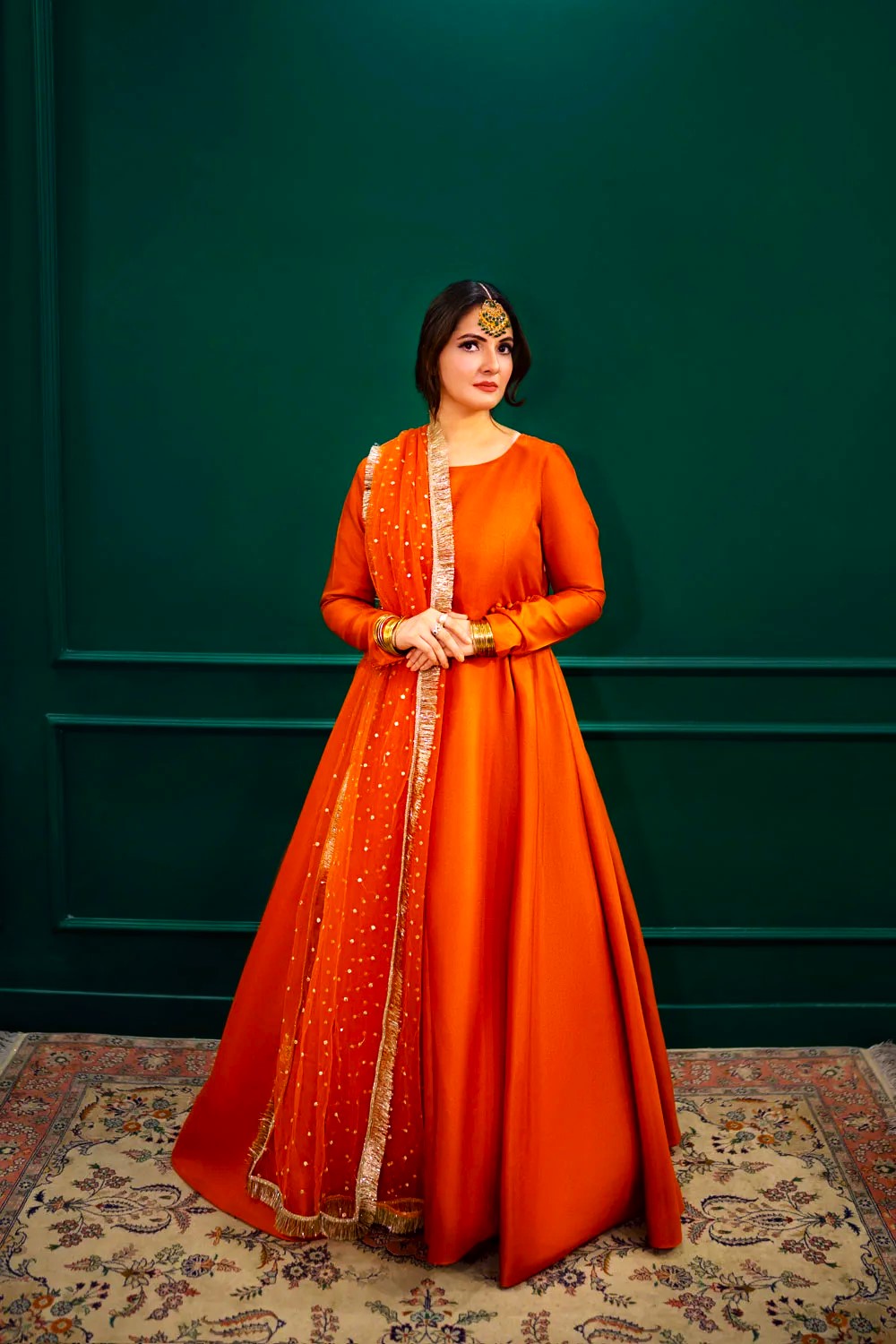
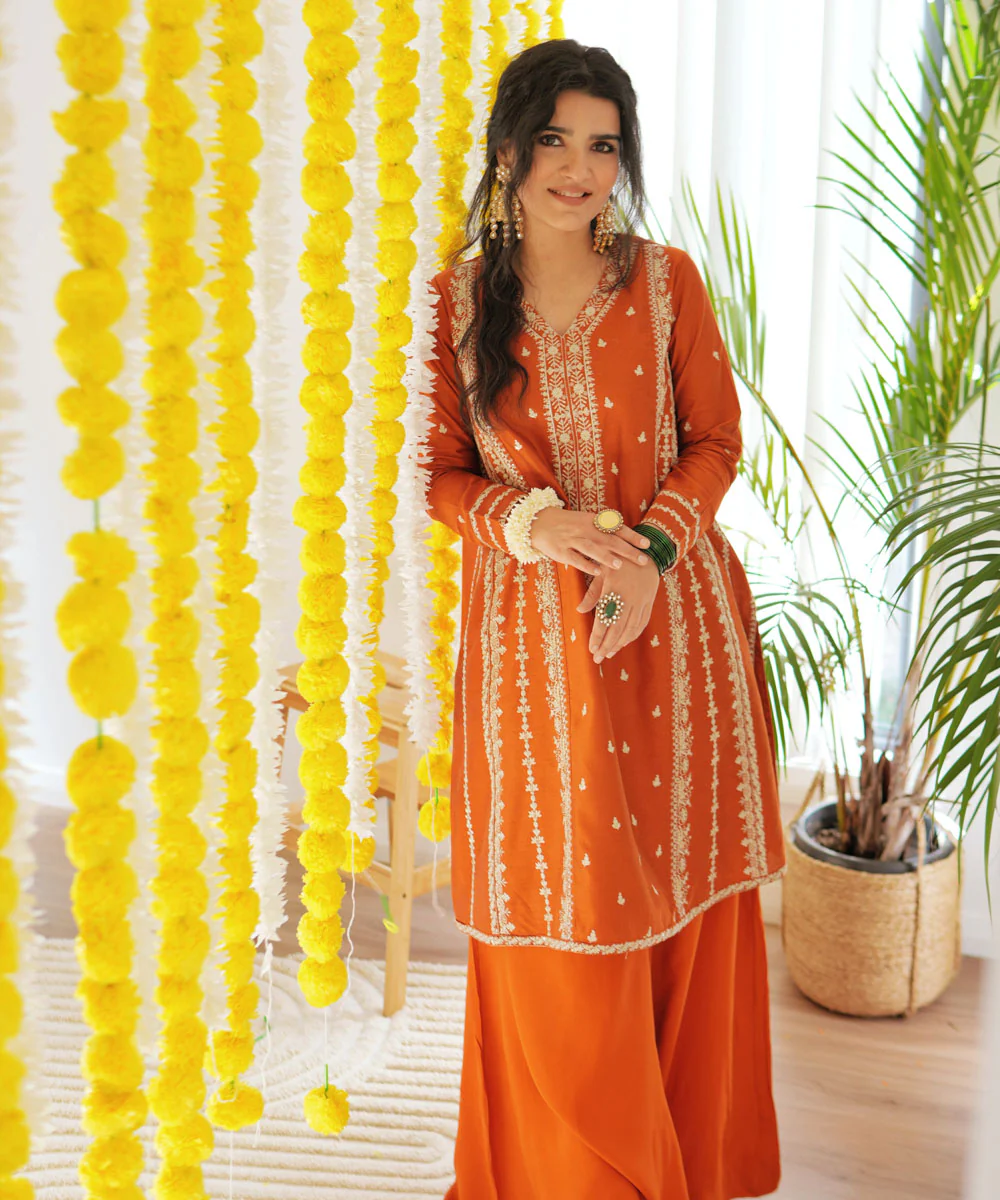
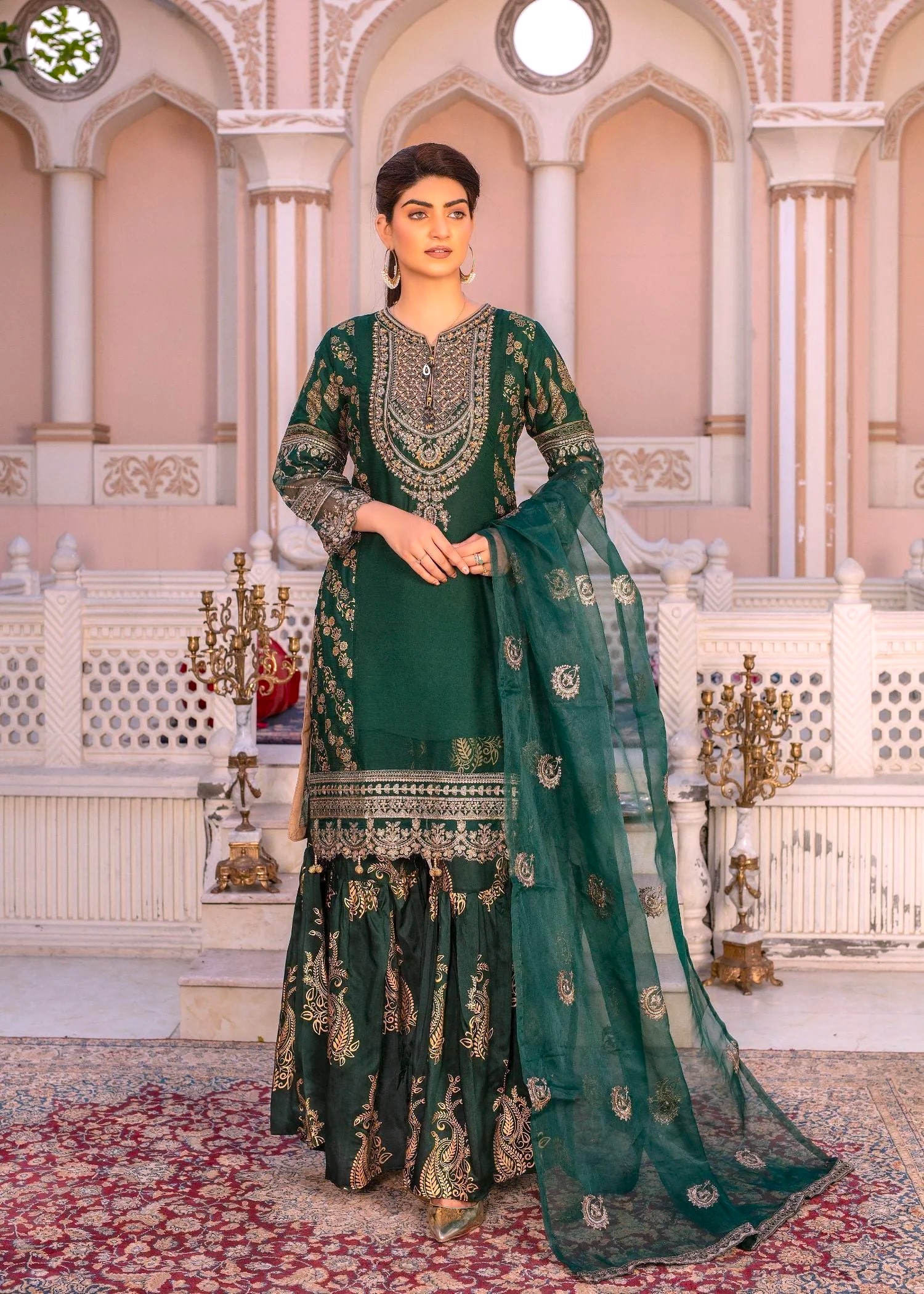
Mehndi dress design and mehndi design
A new mehndi design might inspire a modern cut or pattern on the dress itself, creating a cohesive aesthetic. The goal is a symbiotic relationship where the dress and the mehndi enhance each other, creating a single, stunning visual narrative for the wearer.
- Example: A bright fuchsia lehenga with mirror work embroidery can be perfectly offset by a mehndi design that incorporates similar geometric patterns and shimmer accents.
- Example: A flowing, pastel yellow Anarkali suit provides a soft canvas for a bold, floral mehndi design that sprawls across the arms.
A Journey Through Time: The History and Evolution of Mehndi Dress Design
The tradition of applying mehndi is ancient, with origins tracing back over 5,000 years to the Middle East and North Africa. It was believed to bring good luck, health, and prosperity. The mehndi dress design, as a concept, evolved alongside this ritual. In the subcontinent, the Mehndi ceremony became a pre-wedding festivity, and with it, the need for a special outfit was born.
Initially, women would wear their brightest and newest traditional clothes, often passed down through generations or specially crafted for the occasion. The colors were derived from natural dyes, and the fabrics were simple cottons and silks, heavily embroidered by hand.
The evolution has been remarkable. The late 20th century saw the rise of more structured outfits like the lehenga choli for Mehndi functions. The influence of Bollywood and Pakistani dramas cannot be overstated, popularizing specific colors and styles each season. The 2000s brought in experimental silhouettes and the fusion of Western elements.
Today, the mehndi dress design is a global phenomenon, with designers drawing inspiration from international runways, street style, and even digital art. The modern bride has the freedom to mix and match, creating a look that is deeply personal, whether it’s a traditional mehndi dress design with a vintage feel or a crop top and skirt ensemble with a tattoo design influence on her mehndi.
The Cultural Tapestry: Importance of Mehndi Dress and Mehndi Design in Pakistan
In Pakistan, the Mehndi ceremony is more than just a party; it is a sacred rite of passage filled with symbolism. The mehndi dress design and the mehndi design are integral to this symbolism. The vibrant colors of the dress, particularly yellow and green, are not arbitrary.
They symbolize happiness, new beginnings, fertility, and the vibrancy of life itself. Wearing bright colors is seen as a way to ward off the evil eye and invite positive energy for the couple’s future. The outfit is a celebration of life and love in its most jubilant form.
Similarly, the mehndi design is steeped in meaning. It is not merely decoration. The application process is a meditative, social ritual for the bride. The darkness of the mehndi stain is traditionally believed to reflect the depth of love between the couple. Hidden within the intricate patterns are often the initials of the groom, which he must find on the wedding night, adding a playful element of romance. The entire ensemble—the dress, the jewelry, and the mehndi—works in concert to tell a story of cultural pride, familial blessings, and personal joy. It is a wearable piece of heritage.
- Symbolism in Colors:
- Yellow: Joy, happiness, and sanctity.
- Green: New life, prosperity, and paradise.
- Orange: Energy, enthusiasm, and celebration.
The 2025 Forecast: Top Trends in Mehndi Dress and Mehndi Design
The year 2025 is set to be a groundbreaking one for fashion, blending nostalgia with bold futurism. For your mehndi dress design, expect to see a move towards intelligent and personalized style statements.
For Mehndi Dresses:
- The Return of Regal Velvet: Velvet dress design is making a major comeback, especially for winter Mehndis. Think deep emerald green, royal blue, or even ruby red velvet ensembles with minimal, art-deco inspired embroidery.
- Cape Bliss: Detachable capes, whether heavily embroidered or made of sheer net, add drama and versatility to lehengas and anarkalis. They create a stunning silhouette for photos and can be removed for dancing.
- High-Low Hemlines: Asymmetric hemlines that are shorter in the front and longer at the back offer a modern, playful twist, showing off footwear and allowing for easy movement.
- Sustainable Fashion: A growing trend towards outfits made from organic fabrics, recycled materials, and by artisans paid fair wages. Your celebration look can also be ethically conscious.
- Bold Sleeve Statements:
- Leg-of-Mutton Sleeves: Dramatic and romantic, adding a vintage touch.
- Bell Sleeves: Flowy and elegant, perfect for showcasing mehndi design on the forearms.
For Mehndi Designs:
- Minimalist Tattoo Influences: Clean lines, dotwork, and fine-line patterns inspired by modern tattoo design are huge. These are perfect for brides who want a subtle yet chic look.
- Negative Space Play: Designers are creatively using the natural skin as part of the pattern, creating stunning visual contrast and making the mehndi design appear lighter and more contemporary.
- 3D & Stone Embellishments: The use of tiny gems, pearls, and glitter on top of the dried mehndi paste is evolving, creating textural depth and a jeweled effect.
- Floral Abstraction: Instead of realistic flowers, expect to see abstract, watercolor-style floral patterns that blend seamlessly into the overall design.
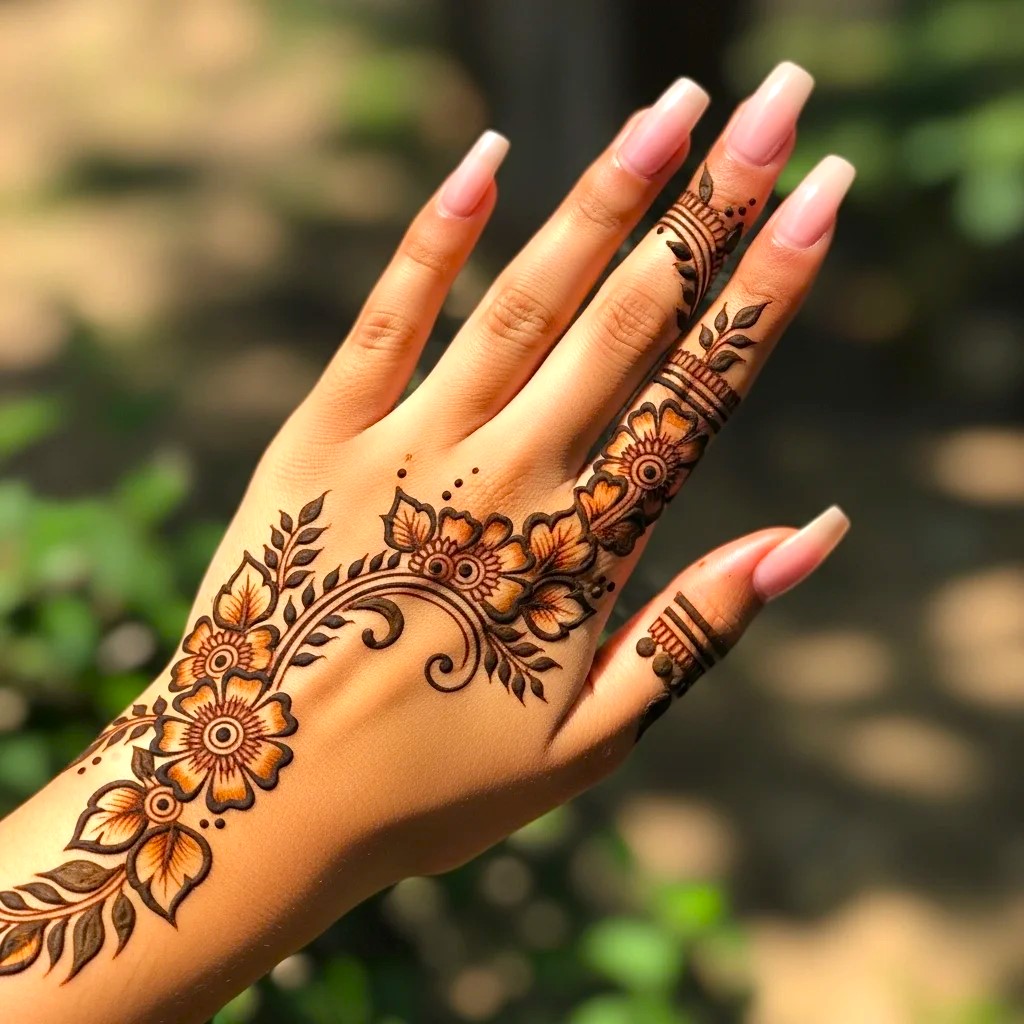
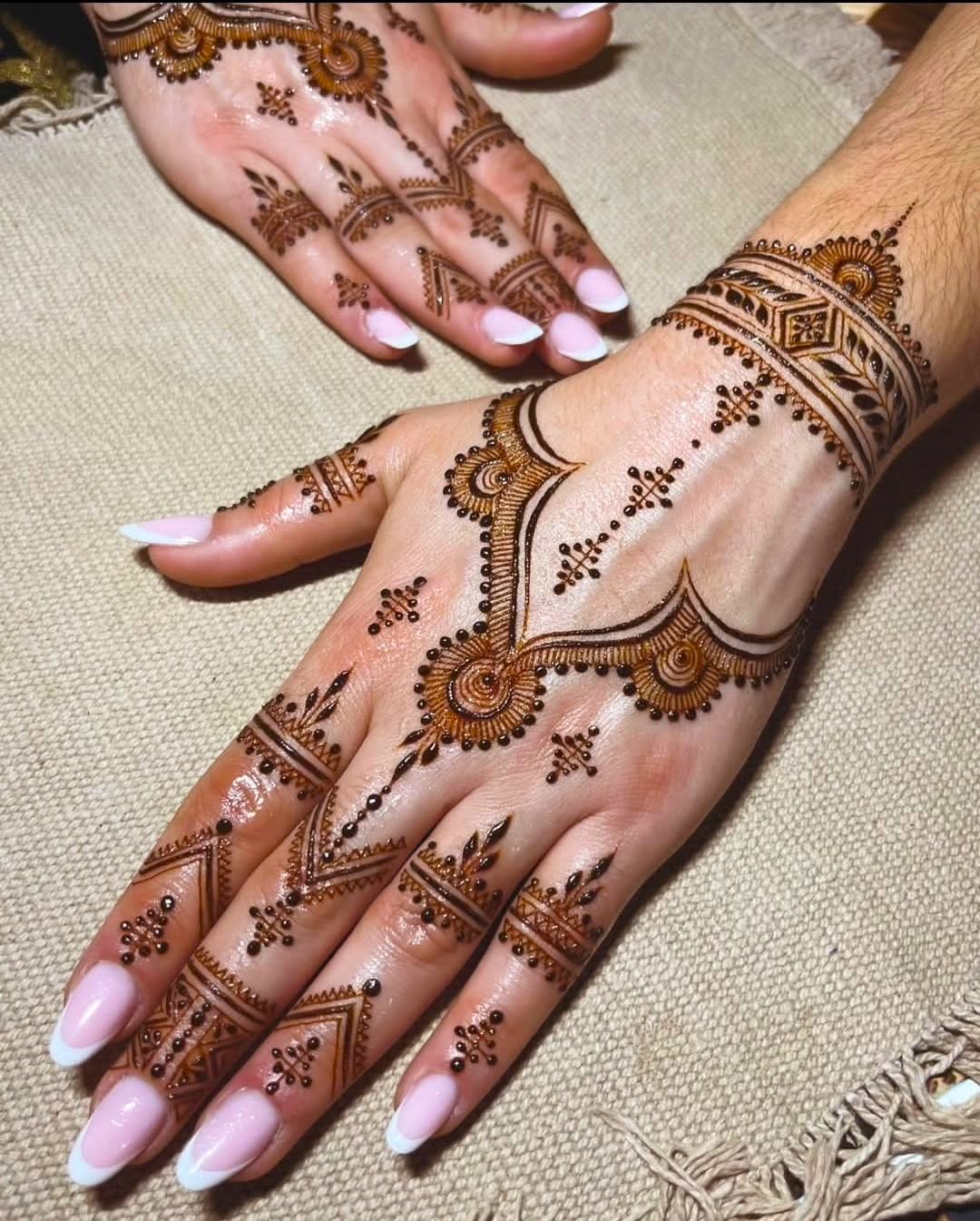
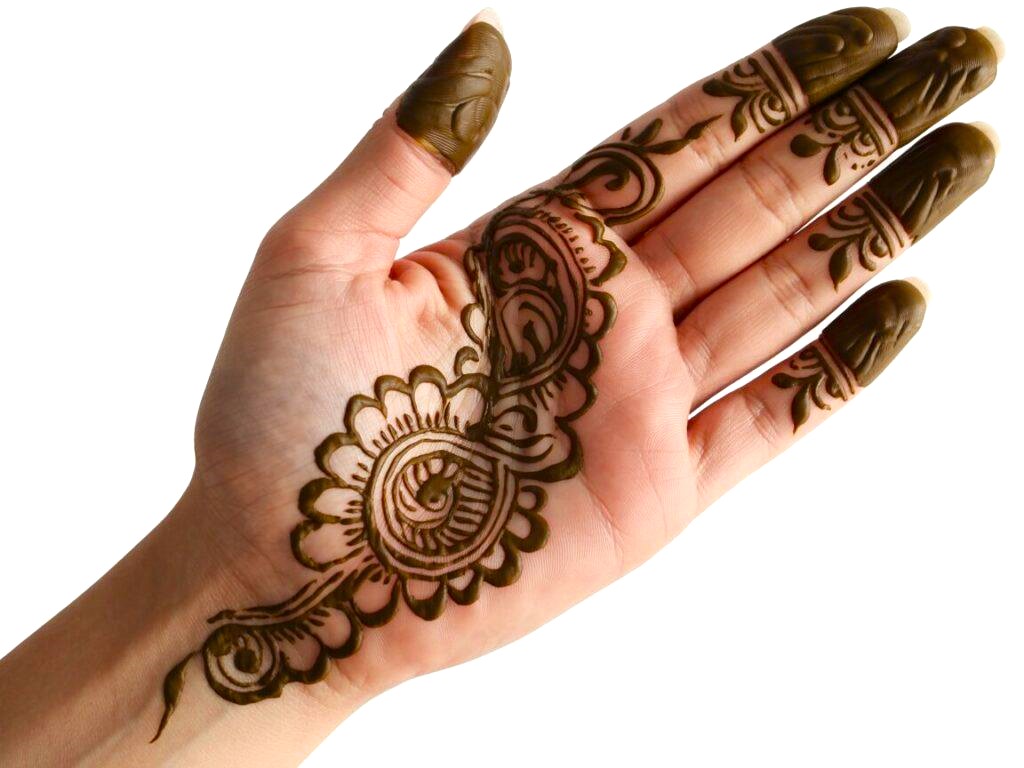
Mehndi dress design and mehndi design
Your Step-by-Step Guide to Choosing the Perfect Mehndi Look
Creating a flawless Mehndi look requires a strategic approach. Follow this step-by-step guide to ensure every element works in perfect harmony.
Step 1: Set Your Budget and Theme. Before you fall in love with a designer piece, define a realistic budget. Also, consider if your ceremony has a specific theme (e.g., rustic, bohemian, art deco) as this will guide your mehndi dress design choices.
Step 2: Find Your Dress Silhouette. Your body type and personal comfort are paramount. Try on different silhouettes—lehenga, sharara, anarkali, gown—to see what makes you feel most confident and comfortable for hours of dancing and sitting.
Step 3: Lock in the Color Palette. While bright colors are traditional, don’t be afraid to explore. A teal, a lavender, or a coral can be just as stunning. Choose a color that complements your skin tone. This is the foundation of your mehndi dress design.
Step 4: Select the Fabric and Embroidery. The fabric dictates the dress’s flow and feel. Choose breezy chiffon for summer or rich velvet dress design for winter. Decide on the embroidery: mirror work, resham, gotta patti, or stonework.
Step 5: Collaborate on Your Mehndi Design. Once you have a picture of your dress, consult with your mehndi artist. Show them the outfit, its embroidery patterns, and color. A good artist will weave elements from your mehndi dress design into the mehndi design.
Step 6: Plan Your Accessories and Hair/Makeup. Choose jewelry that complements rather than overpowers the look. If your dress and mehndi are heavy, opt for simpler jewelry. Your hair and makeup should also align with the overall vibe—glowy, natural makeup often works best.
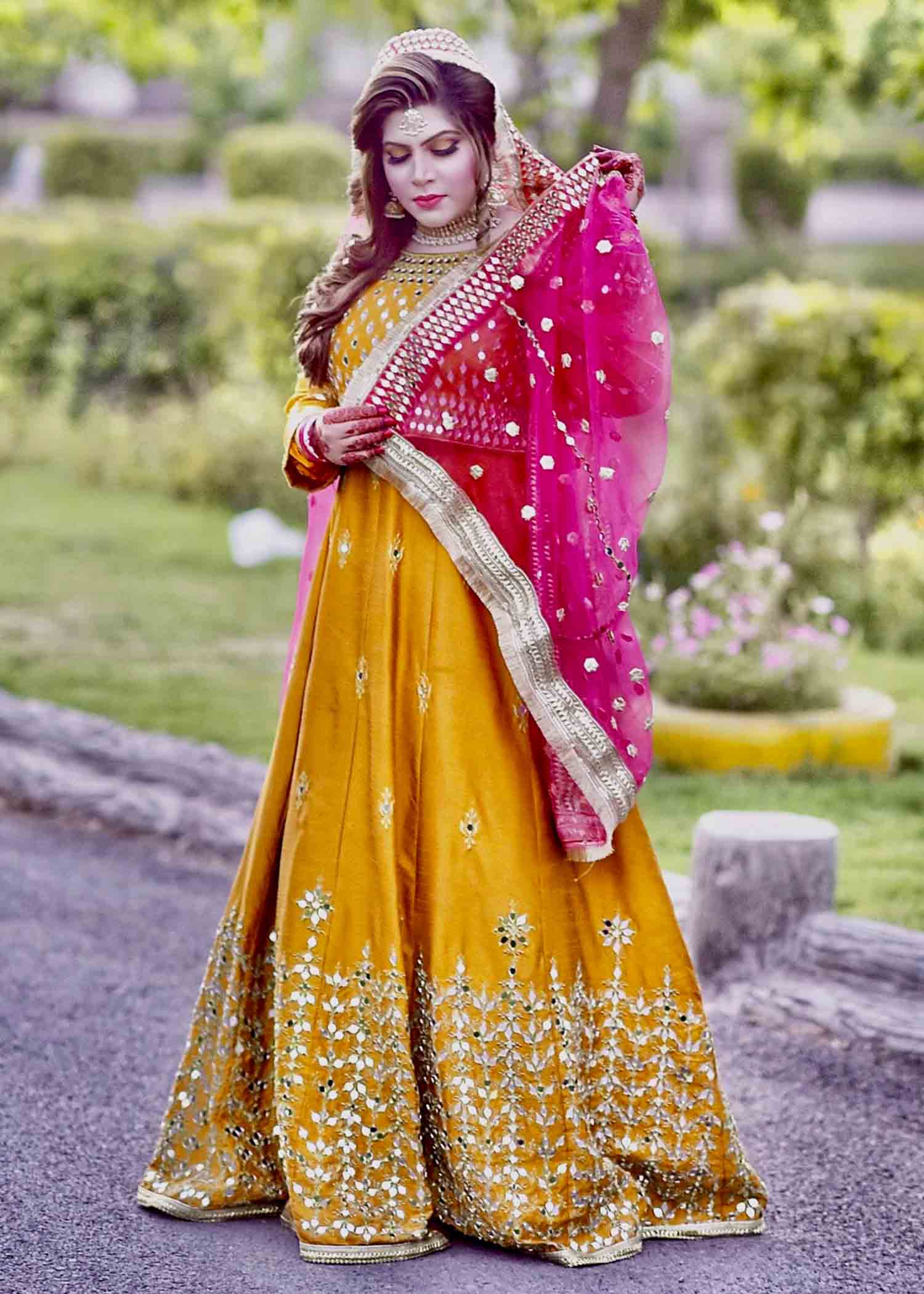
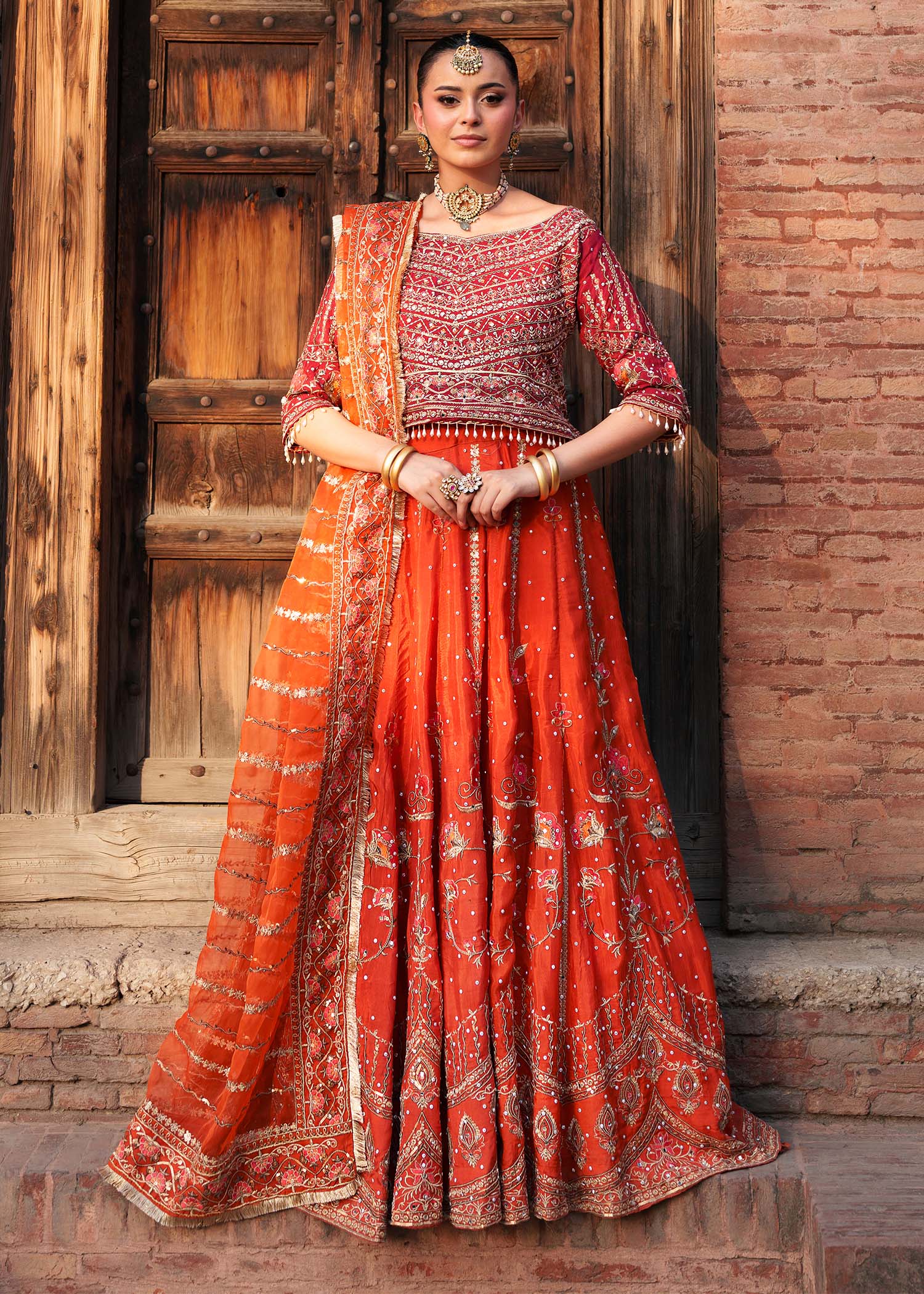
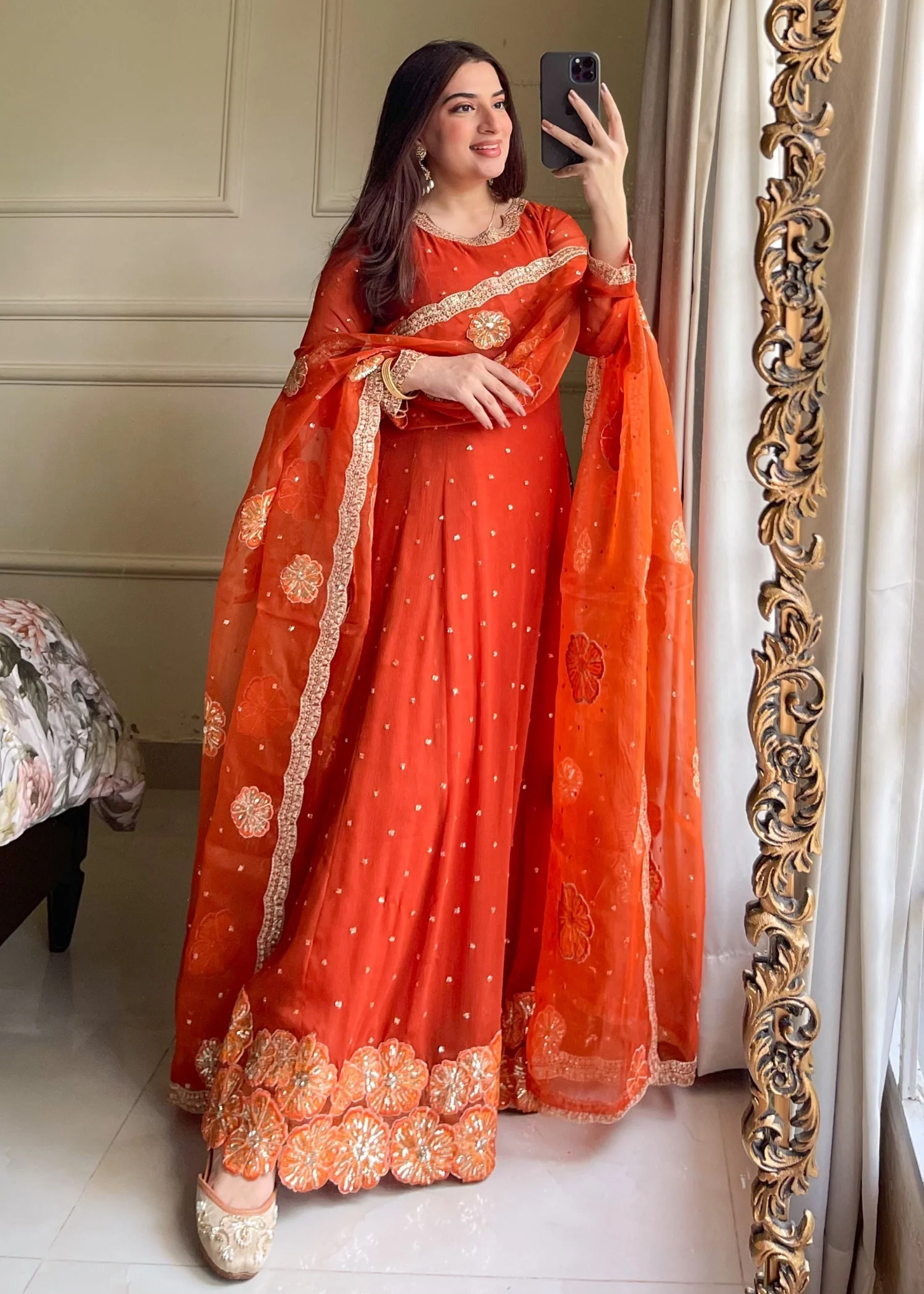
Mehndi dress design and mehndi design
Weighing the Options: Benefits and Drawbacks of Popular Mehndi Dress Choices
Every choice in fashion comes with its own set of pros and cons. Being aware of them helps in making an informed decision.
Heavy Traditional Lehenga (Benefits):
- Offers a quintessential, royal bridal look.
- Extensive embroidery and work make it a standout piece for photographs.
- The heavy fabric can create a beautiful, structured silhouette.
Heavy Traditional Lehenga (Drawbacks):
- Can be very heavy and restrictive for dancing and moving around.
- Often requires multiple people to help drape and manage.
- Can be uncomfortably hot in summer weather.
Lightweight Sharara/Anarkali (Benefits):
- Provides exceptional comfort and ease of movement.
- The flowy fabric creates elegant, photogenic motions.
- Generally more versatile and can be worn again to other events.
Lightweight Sharara/Anarkali (Drawbacks):
- Lighter fabrics may not hold very heavy embroidery well.
- Can sometimes look less “bridal” compared to a voluminous lehenga.
- May require more frequent adjustments.
Contemporary Gown/Pantsuit (Benefits):
- Offers a unique, fashion-forward look that breaks from tradition.
- Can be surprisingly comfortable and easier to manage.
- Allows for a great deal of personalization and modern mehndi dress design integration.
Contemporary Gown/Pantsuit (Drawbacks):
- May not be well-received in very traditional family settings.
- Finding the right balance between “bridal” and “modern” can be challenging.
- Fewer tailors may be experienced in creating fusion wear.
Pro-Tips from the Experts: Insider Secrets for a Flawless Look
To elevate your Mehndi look from great to extraordinary, heed this advice from top designers and mehndi artists.
- Tip 1: Comfort is King. You will be wearing this outfit for hours. Prioritize a well-fitted, comfortable outfit that allows you to breathe, sit, and dance with ease. An uncomfortable bride is not a happy bride.
- Tip 2: The Power of a Trial Run. Never skip a trial for your hair, makeup, and mehndi. This is your chance to see the complete look and make adjustments. A mehndi design trial on a small patch can help test the stain color and pattern.
- Tip 3: Balance is Everything. If your mehndi dress design is heavily embroidered, opt for a mehndi design that is more spaced out or incorporates negative space. If your dress is simple, you can go for a denser, more intricate mehndi pattern.
- Tip 4: Don’t Forget the Feet! Your footwear will be visible, especially during the ceremony. Choose something comfortable yet stylish that matches your outfit. Consider getting a matching mehndi design on your feet as well.
- Tip 5: Hydrate for a Darker Stain. For a dark, long-lasting mehndi stain, stay hydrated and avoid washing your hands with water for as long as possible after the paste is removed. Some experts also suggest applying a sugar-lemon solution to the dried paste.
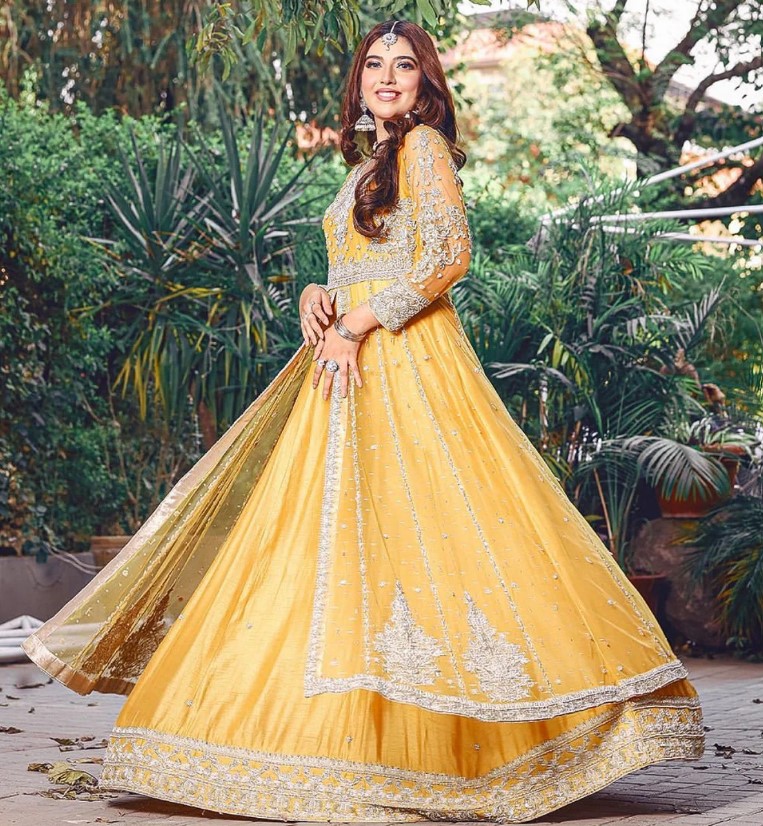
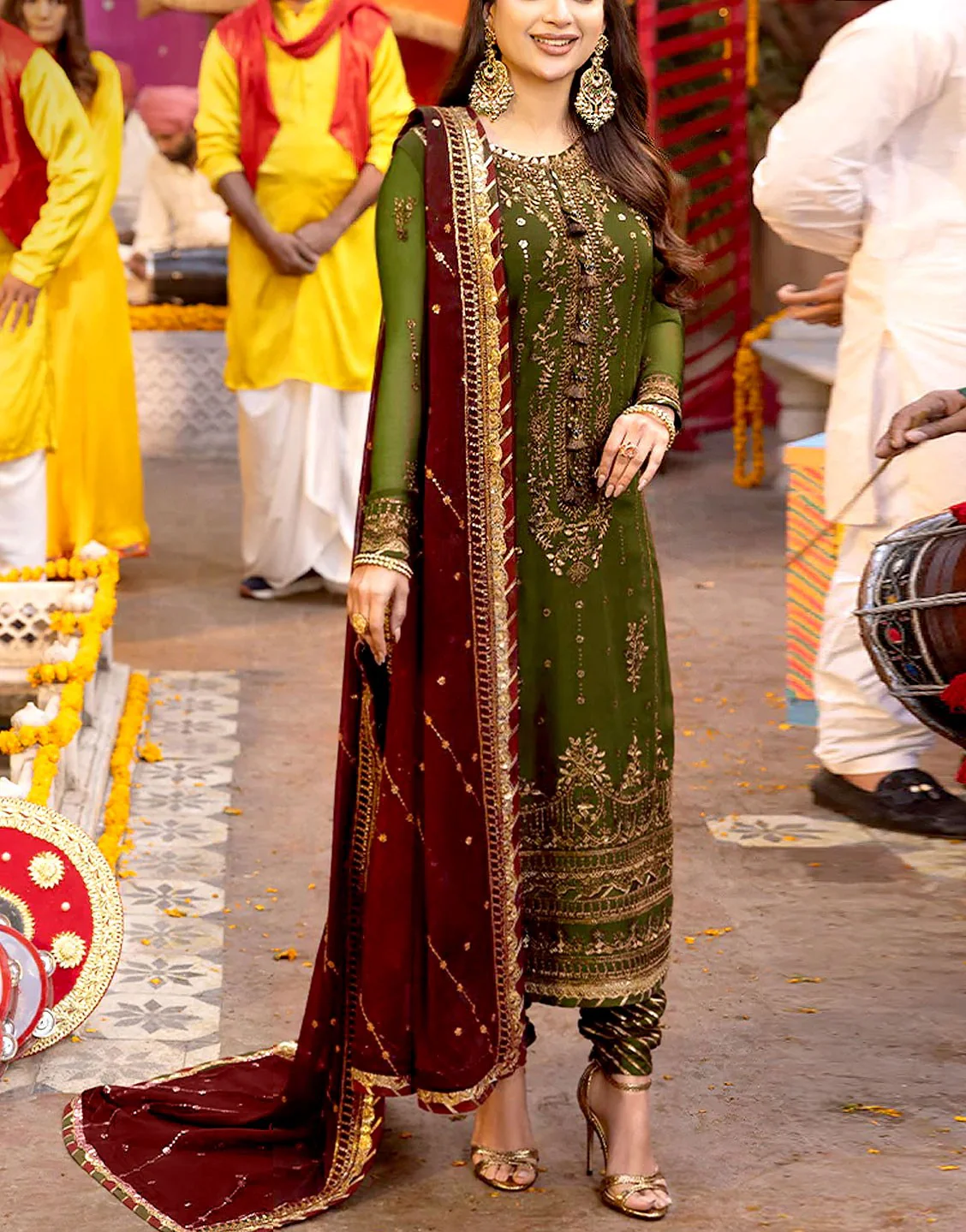
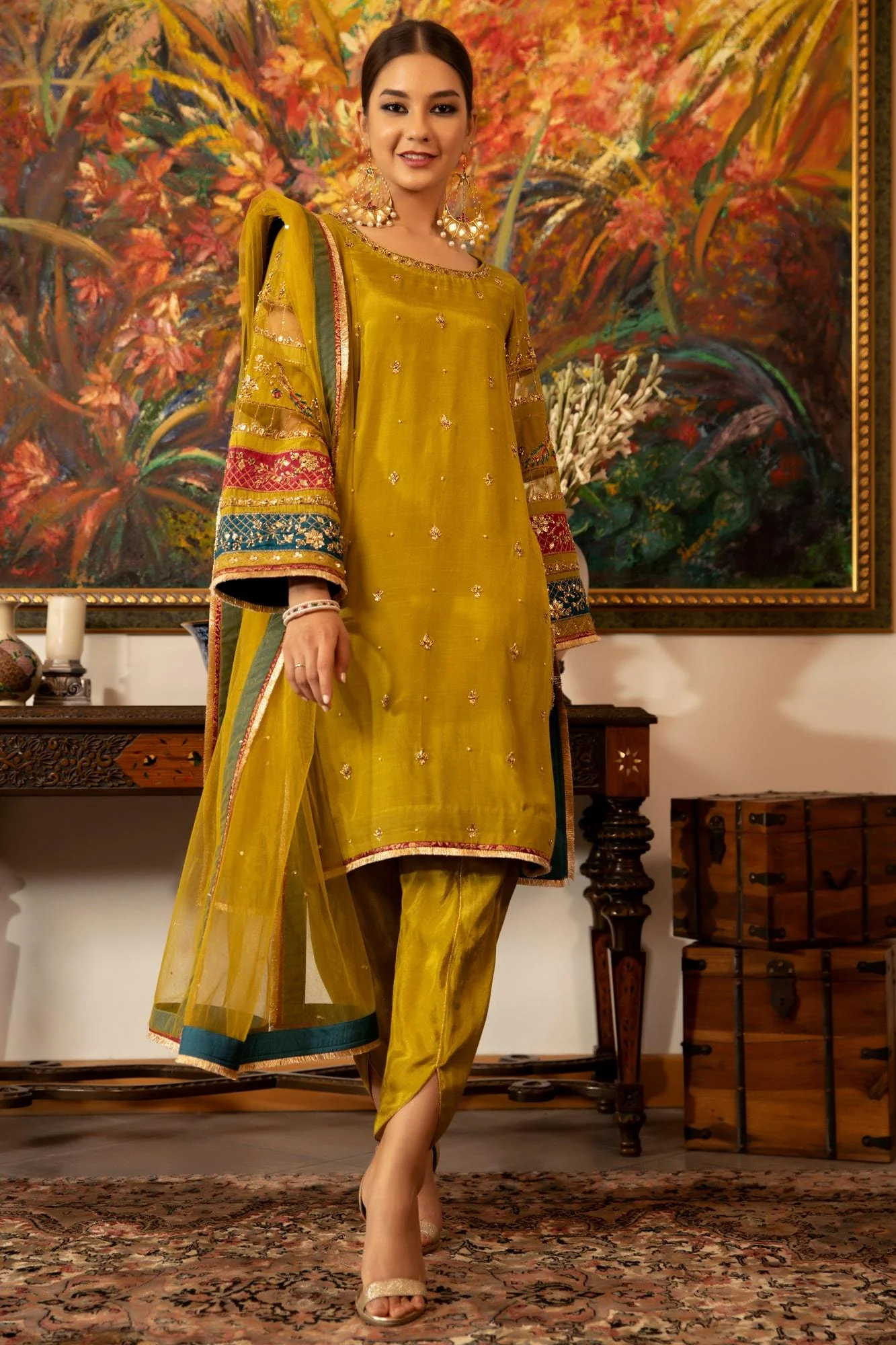
Mehndi dress design and mehndi design
Finding Your Muse: Inspirations for Your Unique Mehndi Dress Design
Feeling stuck? Look to these rich sources of inspiration to spark your creativity.
- Cultural Heritage: Delve into the traditional crafts of Pakistan. Look at Sindhi ajrak patterns, Balochi mirror work, or Kashmiri embroidery for unique motifs for your mehndi dress design and mehndi design.
- Nature’s Palette: The world outside is the greatest artist. Draw inspiration from marigold flowers, peacock feathers, tropical leaves, or even the colors of a sunset.
- Architecture and Art: The geometric patterns of Islamic architecture (like the Badshahi Mosque) or the fluid lines of modern art can be translated into stunning, abstract mehndi design patterns.
- Digital Platforms: Pinterest and Instagram are treasure troves. Create mood boards and follow hashtags like #MehndiDress2025 and #PakistaniMehndiDesign to see what real people and designers are creating globally.
Navigating the Pitfalls: Common Mistakes to Avoid
Awareness of common errors can save you from last-minute fashion disasters.
- Ignoring the Season: A heavy velvet dress design for a humid outdoor summer Mehndi will lead to discomfort. Always choose season-appropriate fabrics.
- Over-Accessorizing: Caking on too many bangles, necklaces, and jhumkas can clutter the look and distract from your beautiful mehndi design. Choose one statement piece.
- Last-Minute Outfit Alterations: Avoid major changes to your outfit a week before the event. This can lead to fitting issues and unnecessary stress.
- Choosing Style Over Comfort: Those sky-high heels might look amazing, but if you can’t walk in them, they will ruin your experience. Opt for stylish yet manageable footwear.
- Not Doing a Hair/Makeup Trial: Assuming your makeup artist will “get it” on the day is a huge risk. A trial ensures you are both on the same page.
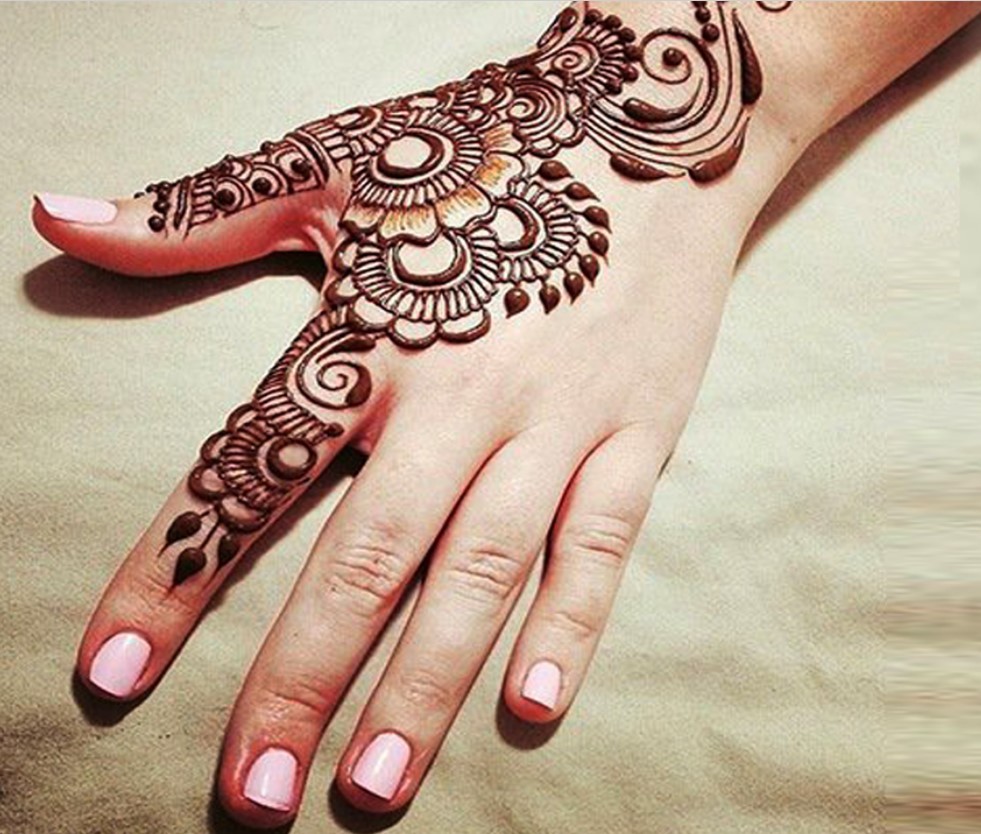
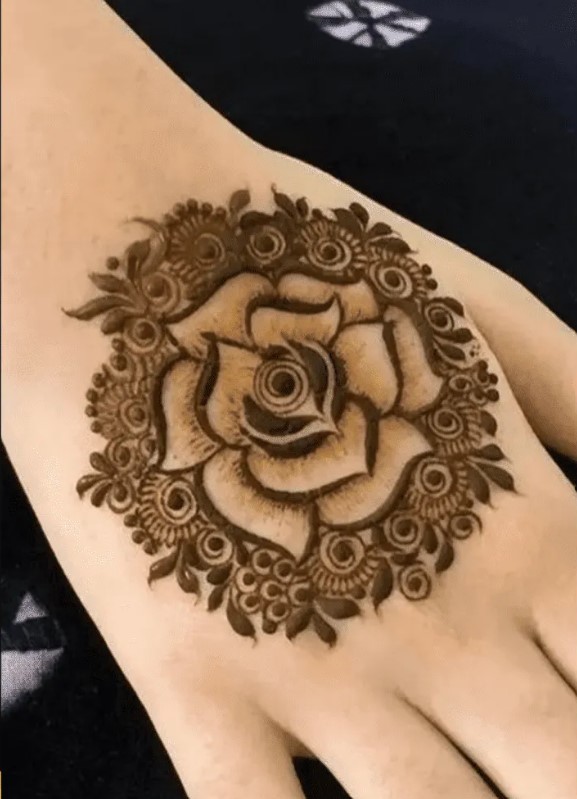
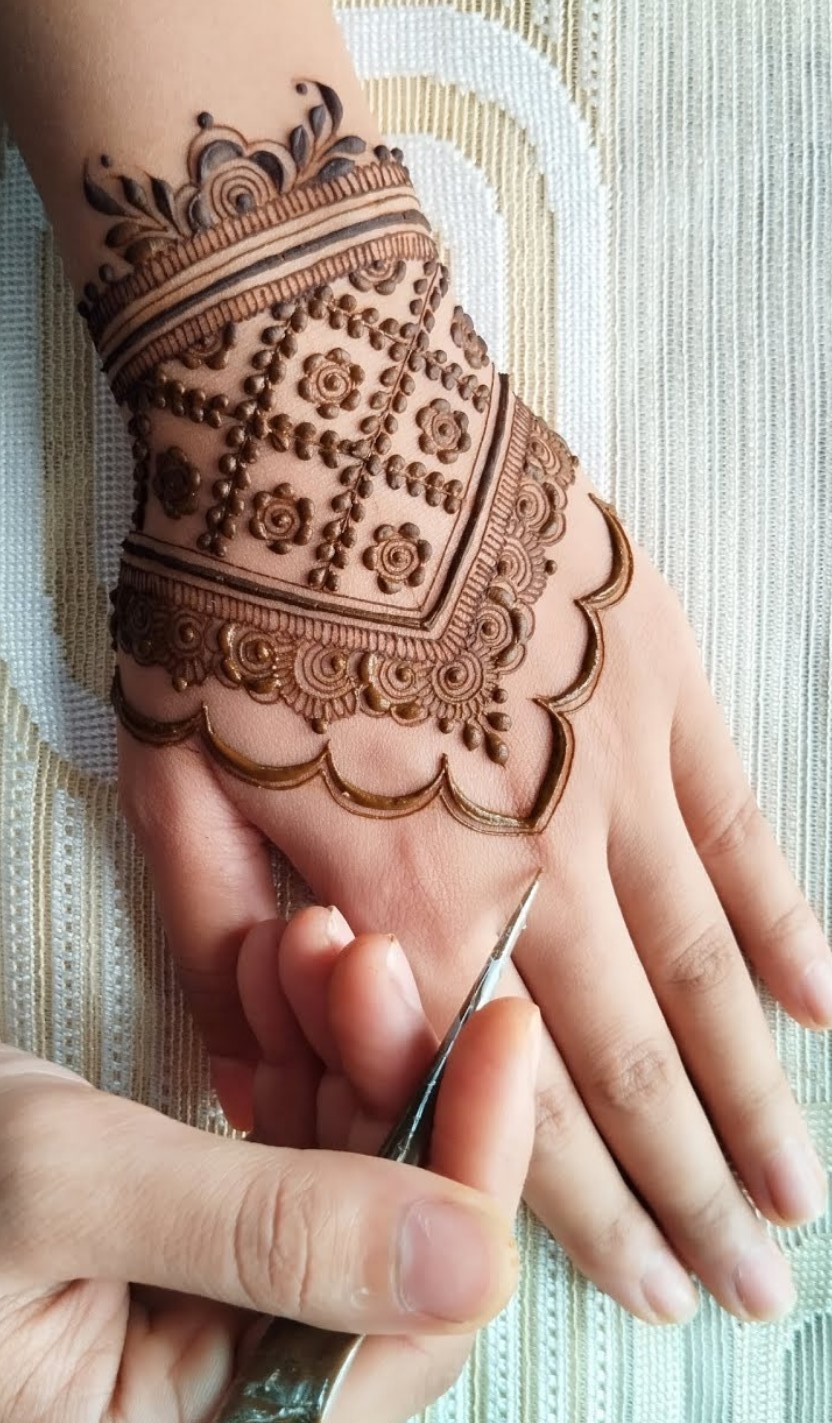
The Future is Bright: The Evolving Scope of Mehndi Fashion
The future of mehndi dress design and mehndi design is incredibly dynamic. We are moving towards even greater personalization and technological integration. Imagine mehndi design incorporating tattoo design elements that use temporary, skin-safe conductive inks to create interactive patterns that light up. Augmented Reality (AR) filters could allow brides to “try on” different mehndi design patterns in real-time before the application.
Sustainability will move from a trend to a norm, with upcycled outfits and organic henna becoming standard. The fusion of global influences will continue, creating a truly cosmopolitan mehndi dress design language that still respects its cultural roots. The new mehndi design will likely become more personalized, telling the unique story of the couple through symbols, dates, and motifs that are meaningful to them alone. The canvas of celebration is only getting bigger and more innovative.
Frequently Asked Questions (FAQs)
1. What is the best color for a mehndi dress design?
Traditionally, bright colors like yellow, green, and orange are popular as they symbolize joy and celebration. However, modern brides are exploring shades like coral, lavender, and teal. The best color is one that complements your skin tone and makes you feel confident.
2. How can I make my mehndi design last longer?
For a darker, longer-lasting stain, keep the mehndi paste on for as long as possible (6-8 hours). Avoid water contact initially, apply a sugar-lemon sealant, and moisturize with natural oils like coconut or olive oil in the following days.
3. Can I wear a velvet dress design for a summer mehndi?
It is not recommended. Velvet is a heavy, warm fabric that can be extremely uncomfortable in summer heat. Opt for breezier fabrics like chiffon, georgette, or cotton silk for a summer ceremony.
4. What is the difference between traditional mehndi and tattoo design-inspired mehndi?
Traditional mehndi design features dense, intricate patterns of paisleys, florals, and peacocks. Tattoo design-inspired mehndi uses cleaner lines, dotwork, geometric shapes, and minimalist motifs, often covering less skin.
5. How do I match my mehndi design to my dress?
Show your mehndi artist pictures of your mehndi dress design, including its embroidery patterns and colors. They can incorporate similar motifs, lines, or the overall “vibe” of the outfit into the henna art for a cohesive look.
6. What are some new mehndi design trends for 2025?
Key trends for 2025 include minimalist tattoo-inspired art, extensive use of negative space, abstract floral patterns, and the use of 3D embellishments like gems and stones on the dried mehndi paste.
7. Are there any colors I should avoid for my mehndi dress?
While there are no strict rules, very dark colors like black or navy can sometimes be considered inappropriate for the joyful nature of a Mehndi. White is also typically avoided as it’s associated with other functions.
8. How far in advance should I book my mehndi artist?
For a bride, it’s advisable to book a skilled mehndi artist at least 3-6 months in advance, especially during peak wedding season. This ensures you get your preferred artist and allows time for a consultation and design trial.
9. What kind of jewelry goes best with a heavily embroidered mehndi dress design?
With a heavily worked dress and intricate mehndi, less is more. Opt for statement but simple jewelry, like a single bold necklace (Rani Haar) or just stunning jhumkas, to avoid a cluttered look.
10. Can I have a Western-style gown as my mehndi dress?
Absolutely! Fusion wear is hugely popular. A colorful, embroidered Western-style gown or even a pantsuit can make for a stunning and unique mehndi dress design, perfectly reflecting your personal style.

